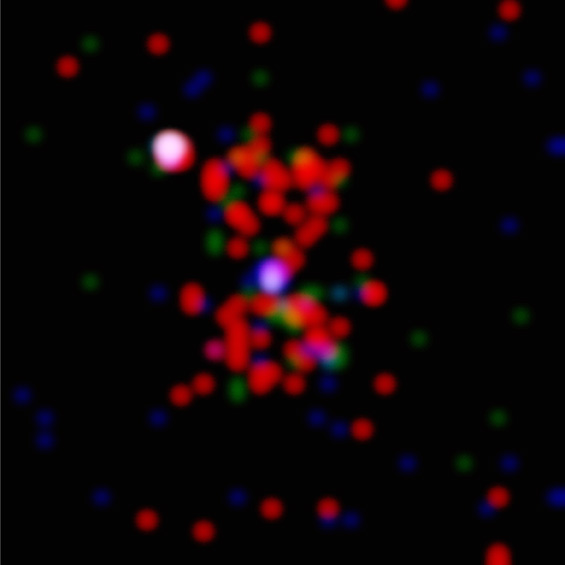
 Credit: NASA/IoA/A.Fabian et al.
Credit: NASA/IoA/A.Fabian et al.
Youngest X-ray Galaxy Cluster
Clusters of galaxies are among the largest structures in the Universe; in
fact the Universe itself is in many ways just a collection of these
clusters (and clusters of clusters, called superclusters). Galaxy clusters
are usually surrounded by a halo of very hot gas (at temperatures of
millions of degrees). Since these gas halos are so hot they produce mostly
X-ray radiation, and so may be studied best using X-ray telescopes. The Chandra X-ray Observatory has now
imaged an X-ray halo around a distant cluster centered on a galaxy known as
3C 294. The image
above shows the galaxy as a blue-white dot at the center of the image
surrounded by an X-ray halo, seen as a faint red haze. The colors in this
image represent X-ray energy, so that low energy X-rays are red, medium
energy X-rays are green, and high energy X-rays are blue; a source which
emits equally at all X-ray energies would thus appear white. Thus the
galaxy itself emits high energy X-rays but also some lower energy X-rays;
the halo emits only low-energy X-rays. The study of X-ray halos allows
astronomers to determine the mass hidden in the cluster, and to determine
the chemistry of the gas in the halo. With its capability to study the
most distant clusters, Chandra lets astronomers see how clusters of
galaxies drive the evolution of the Universe.
Last Week *
HEA Dictionary * Archive
* Search HEAPOW
* Education
Each week the HEASARC
brings you new, exciting and beautiful images from X-ray and Gamma ray
astronomy. Check back each week and be sure to check out the HEAPOW archive!
Page Author: Dr. Michael F. Corcoran
Last modified June 25, 2001


